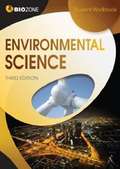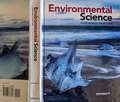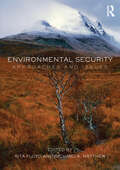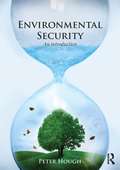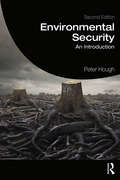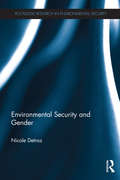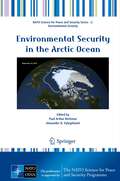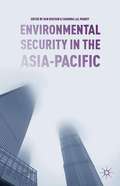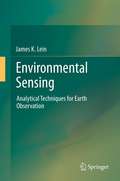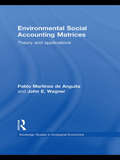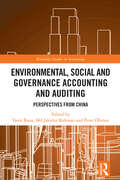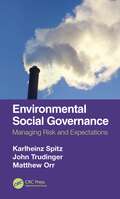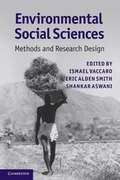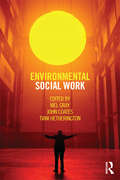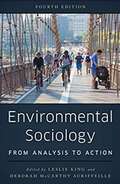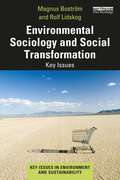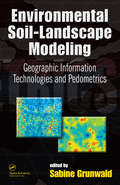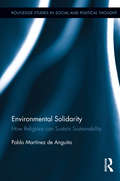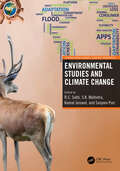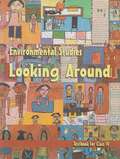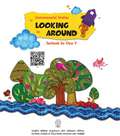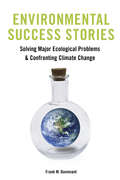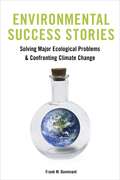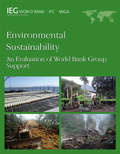- Table View
- List View
Environmental Science Student Workbook (Third Edition)
by Tracey Greenwood Kent Pryor Lisa Bainbridge-Smith Richard AllanEnvironmental Science introduces students to the Earth's physical and biological systems, and the interactions of humans with these. This revision introduces new content and aligns the workbook to its supporting digital resources. Content developments include updates on the Gulf of Mexico oil spill and the Fukushima Daiichi nuclear disaster, and in-depth coverage of energy extraction issues, pollution, and the wider environmental implications of urban development. The ideal companion to both the APES curriculum and the IB Environmental Systems and Societies.
Environmental Science: Your World, Your Turn
by Jay WithgottPhenomena drives student engagement in the all new Environmental Science - coming Back to School 2020! An Anchoring Phenomena launches scientific inquiry in every topic supported by a Claim-Evidence-Reasoning activity and Problem-Based Learning project.Students make sense of the Anchor with 19 Investigative Phenomena Case Studies. These authentic, real-world applications of Environmental Science excite students and inspire their passion for the environment.
Environmental Security: Approaches and Issues
by Rita Floyd Richard MatthewEconomic development, population growth and poor resource management have combined to alter the planet’s natural environment in dramatic and alarming ways. For over twenty years, considerable research and debate have focused on clarifying or disputing linkages between various forms of environmental change and various understandings of security. At one extreme lie sceptics who contend that the linkages are weak or even non-existent; they are simply attempts to harness the resources of the security arena to an environmental agenda. At the other extreme lie those who believe that these linkages may be the most important drivers of security in the 21st century; indeed, the very future of humankind may be at stake. This book brings together contributions from a range of disciplines to present a critical and comprehensive overview of the research and debate linking environmental factors to security. It provides a framework for representing and understanding key areas of intellectual convergence and disagreement, clarifying achievements of the research as well as identifying its weaknesses and gaps. Part I explores the various ways environmental change and security have been linked, and provides principal critiques of this linkage. Part II explores the linkage through analysis of key issue areas such as climate change, energy, water, food, population, and development. Finally, the book concludes with a discussion of the value of this subfield of security studies, and with some ideas about the questions it might profitably address in the future. This volume is the first to provide a comprehensive overview of the field. With contributions from around the world, it combines established and emerging scholars to offer a platform for the next wave of research and policy activity. It is invaluable for both students and practitioners interested in international relations, environment studies and human geography.
Environmental Security: An Introduction
by Peter HoughThis student-friendly textbook offers a survey of the competing conceptions and applications of the increasingly prominent notion of environmental security. The book is divided into three sections. In the first, the key theoretical and practical arguments for and against bringing together environmental and security issues are set out. The book then goes on to present how and why environmental issues have come to be framed in some quarters as ‘national security‘ concerns in the context of the effects of overpopulation, resource depletion, climate change and the role of the military as both a cause and a solution to problems of pollution and natural disasters. Finally, the third section explores the case for treating the key issues of environmental change as matters of human security. Overall, the book will provide a clear, systematic and thorough overview of all dimensions of an area of great academic and ‘real-world’ political interest but one that has rarely been set out in an accessible textbook format hitherto. This book will be essential reading for students of environmental studies, critical and human security, global governance, development studies, and IR in general.
Environmental Security: An Introduction
by Peter HoughThis textbook offers a student-friendly survey of the global politics of the environment through the prism of security studies. This book is divided into three thematic sections. The first part sets out the key theoretical and practical arguments for and against bringing together environmental and security issues. The second part examines why environmental issues have been framed by some as ‘national security‘ concerns in the context of the effects of overpopulation, resource depletion, climate change and the role of the military as both a cause and a solution to problems of pollution and natural disasters. Finally, the third section explores the case for treating the key issues of environmental change as matters of human security. The chapters have been updated to include the 2015 Paris Climate Change Accords, the Trump and Sendai Framework for Disaster Risk Reduction, and there is a new chapter on environmental history. Overall, the book provides a clear, systematic and thorough overview of an area of great academic and ‘real-world’ political interest. This book will be essential reading for students of environmental studies, critical and human security, human geography, development studies, and International Relations in general.
Environmental Security and Gender (Routledge Research in Environmental Security)
by Nicole DetrazOver the past 20 years scholars, policymakers, and the media have increasingly recognized the links between both traditional and non-traditional security issues and the changing condition of the global environment. Concepts such as 'environmental security' and 'resource conflict' have been used to hint at these significant linkages. While there has been a good deal of scholarly work conducted that seeks to identify the ways that actors link these concepts, there has been little examination of the intersection between approaches to environmental security and gender. This book explores this intersection to provide an insight into the gendered nature of both global environmental politics and security studies. It examines how the issues of security and the environment are linked to theory and practice, and the extent to which gender informs these discussions. By adopting a feminist environmental security discourse, this book provides crucial redefinitions of key concepts and offers new insights into the ways we understand security-environment connections. Case studies evaluate if, and how, environment and security discourses are being used to understand a range of environmental issues, and how a feminist environmental security discourse contributes to our understanding of security-environment connections. This multidisciplinary volume draws on literature from the environmental sciences, security studies and sociology to highlight the complex human insecurities that often accompany environmental change. As conceptualizations of security continue to shift and broaden to include environmental issues and concerns, it is imperative that gender informs the debate.
Environmental Security in the Arctic Ocean
by Paul Arthur Berkman Alexander N. VylegzhaninThis seminal book results from a NATO Advanced Research Workshop at the University of Cambridge with Russian co-directorship, enabling the first formal dialogue between NATO and Russia about security issues in the Arctic Ocean. Involving interdisciplinary participation with experts from 17 nations, including all of the Arctic states, this workshop itself reflects progress in Arctic cooperation and collaboration. Interests now are awakening globally to take advantage of extensive energy, shipping, fishing and tourism opportunities in the Arctic Ocean as it is being transformed from a permanent sea-ice cap to a seasonally ice-free sea. This environmental state-change is introducing inherent risks of political, economic and cultural instabilities that are centralized among the Arctic states and indigenous peoples with repercussions globally. Responding with urgency, environmental security is presented as an "integrated approach for assessing and responding to the risks as well as the opportunities generated by an environmental state-change." In this book - diverse perspectives on environmental security in the Arctic Ocean are shared in chapters from high-level diplomats, parliamentarians and government officials of Arctic and non-Arctic states; leaders of Arctic indigenous peoples organizations; international law advisors from Arctic states as well as the United Nations; directors of inter-governmental organizations and non-governmental organizations; managers of multi-national corporations; political scientists, historians and economists; along with Earth system scientists and oceanographers. Building on the "common arctic issues" of "sustainable development and environmental protection" established by the Arctic Council - environmental security offers an holistic approach to assess opportunities and risks as well as develop infrastructure responses with law of the sea as the key "international legal framework" to "promote the peaceful uses" of the Arctic Ocean. With vision for future generations, environmental security is a path to balance national interests and common interests in the Arctic Ocean for the lasting benefit of all.
Environmental Security in the Asia-Pacific
by Iain Watson Chandra Lal PandeyEnvironmental security has been one of the greatest threats of the twenty-first century. Crossing the tipping point of two degrees Celsius is projected to be catastrophic, but perennial policy gridlock at the United Nations' multilateral climate change negotiations has so far prevented significant progress. The Asia-Pacific region has much at stake in these negotiations—it is often regarded as the most climate-vulnerable region in the world and also harbors the largest number of poorpeople already affected and in danger of being affected by climate change. Existing climate change literature frames issues through the prism of North-South relations. In contrast, this book focuses on both North-South and South-South relations to reveal an understanding of major climate change and climate change management issues through practices and narratives of environmental security in a specific regional context. The case studies are diverse and represent both large emitters like China and India and the smallest emitter, Nepal, as well as resource-cursed Indonesia, dilemmatic New Zealand, and green visionaries Korea and Japan. Contributors analyze causal interlinkages that affect environmental security policy from both geopolitical and geoeconomic dynamics.
Environmental Security in Watersheds: The Sea of Azov
by Viktor LagutovWatersheds, supplying crucial ecosystem services to humans, seem to be a logical territorial unit to integrate societal benefits and environmental needs in order to evaluate the sustainability of natural resource use patterns. Based on this belief the book is an attempt to initiate a comprehensive environmental security assessment in the basin of the Azov Sea, shared by Russia and Ukraine. Though the region provides a variety of essential services and plays a strategic role in national and international development plans, it has been excluded from most regional environmental discussions. At the same time there is an alarming degradation rate of basin freshwater ecosystems that has occurred due to overutilization of certain prioritized services (e.g. transportation). The collapse of neglected services (e.g. fishery and freshwater supply) poses serious threats to the national economies as well as the local population, and to mitigate these threats priority in water management should be given to securing sustainability of the regional freshwater ecosystems. In addition to the review of the current status of Azov ecosystem services, the authors analyze likely future availability and challenges. The relevant experience derived from basin management of the Black Sea and other similar basins is also discussed.
Environmental Sensing
by James K. LeinRemote sensing has witnessed a renaissance as new sensor systems, data collection capabilities and image processing methodologies have expanded the technological capabilities of this science into new and important applications areas. Perhaps nowhere has this trend been more evident than in the study of earth environments. Within this broad application area remote sensing has proven to be an invaluable asset supporting timely data gathering at a range of synoptic scales, facilitating the mapping of complex landscapes and promoting the analysis of environmental process. Yet remote sensing's contribution to the study of human/environmental interaction is scattered throughout a rich and diverse literature spanning the social and physical sciences, which frustrates access to, and the sharing of the knowledge gained through, these recent advances, and inhibits the operational use of these methods and techniques in day to day environmental practice, a recognized gap that reduces the effectiveness of environmental management programs. The objective of this book is to address this gap and provide the synthesis of method and application that is currently missing in the environmental science, re-introducing remote sensing as an important decision-support technology.
Environmental Social Accounting Matrices: Theory and Applications (Routledge Studies in Ecological Economics #7)
by Pablo Martínez de Anguita John E. WagnerIn this book Professors Pablo Martínez de Anguita and John E. Wagner put two disciplines together, regional and ecological economics, presenting a way to understand ecological economic concerns from a regional perspective, and providing a mathematical tool to measure their interrelationships. This book offers different regional economic models that explicitly include the role of the natural resources and pollutants in economic regions through the use of Social Accounting Matrixes and Input-output models. The main objective of this book is to explore Input-output and Social Accounting Matrix (SAM) models by expanding the accounts to include natural resources and the environment. The proposed models in this book incorporate the forest and other natural resources and pollutants as a component in a larger model of how the economy and environment of larger areas interact. This book will be of interests to postgraduates, researchers and scientists in the fields of regional, resource, environmental, or ecological economics.
Environmental, Social and Governance Accounting and Auditing: Perspectives from China (Routledge Studies in Accounting)
by Tarek Rana Md Jahidur Rahman Peter ÖhmanIn a rapidly evolving world where Environmental, Social, and Governance (ESG) considerations are at the forefront of business and investment decisions, understanding the intricate interplay between ESG factors and corporate performance is paramount. This book demystifies ESG by providing empirical insights from the unique perspective of China, shedding light on the impact of ESG on financial performance and corporate governance. It investigates the impact of environmental expertise, social variability, and board governance model on firm performance.The book sets the stage by introducing the reader to the significance of ESG in today's corporate world, examining empirical evidence gathered from a decade of data analysis on Chinese-listed companies. It explores how ESG practices influence corporate financial performance and what role audit quality plays in this equation. Drawing from a wealth of data, it provides practical insights into the effects of ESG disclosure, ownership structures, corporate governance, and more on the performance of businesses. It offers a clear understanding of the empirical realities in China while addressing a global audience interested in harnessing ESG for sustainable corporate success. It provides valuable lessons and comparisons that can benefit readers beyond China's borders.The book bridges the gap between research and practice, translating complex research findings into actionable recommendations, enhancing its appeal to both academic and professional audiences. It is a must-read for scholars, students and researchers seeking actionable insights into the world of ESG. Further, it discusses ESG practice and policy implications, offering recommendations for stakeholders including policymakers, investors, managers, and auditors.
Environmental Social Governance: Managing Risk and Expectations
by Karlheinz Spitz John Trudinger Matthew OrrIncreasingly, companies are being judged by their performance in terms of Environmental Social Governance (ESG). But exactly what does it mean, and what should be done about it? While much ambiguity exists, it is no longer sufficient to negotiate the environmental assessment process successfully. ESG is an ongoing process that spans the entire life cycle of a company and its operations. This book is aimed at business leaders – senior executives and company directors – and particularly those involved in the extractive industries and other ventures that significantly affect the environment and host communities. Guidance is provided on the major ESG issues that confront all business leaders. Strategies are provided to address ESG risk and to handle crises when they occur. QUESTIONS FOR BUSINESS LEADERS: Are you at all prepared for an environmental or social crisis event? How will you cope with the "unknown unknowns"? What do your shareholders expect you to do about climate change? Are your employees proud of the company’s ESG performance? How does your bank evaluate your biodiversity impacts?
Environmental Social Sciences: Methods and Research Design
by Ismael Vaccaro Eric Alden Smith Shankar AswaniThe relationship between human communities and the environment is extremely complex. In order to resolve the issues involved with this relationship, interdisciplinary research combining natural sciences, social sciences, and humanities is necessary. Here, specialists summarise methods and research strategies for various aspects of social research devoted to environmental issues. Each chapter is illustrated with ethnographic and environmental examples, ranging from Australia to Amazonia, from Madagascar to the United States, and from prehistoric and historic cases to contemporary rural and urban ones. It deals with climate change, deforestation, environmental knowledge, natural reserves, politics and ownership of natural resources, and the effect of differing spatial and temporal scales. Contributing to the intellectual project of interdisciplinary environmental social science, this book shows the possibilities social science can provide to environmental studies and to larger global problems and thus will be of equal interest to social and natural scientists and policy makers.
Environmental Social Work: Racial Preference In Black And White (Positions: Education, Politics, And Culture Ser.)
by Tim J. WiseSocial work has been late to engage with the environmental movement. Often working with an exclusively social understanding of environment, much of the social work profession has overlooked the importance of environmental issues. However, recently, the impact of and worldwide attention to climate change, a string of natural disasters, and increased understanding of issues around environmental justice has put the environment, sustainability, and well-being in the spotlight. Divided into three parts, this field-defining work explores what environmental social work is, and how it can be put into practice. The first section focuses on theory, discussing ecological and social justice, as well as sustainability, spirituality and human rights. The second section comprises case studies of evolving environmental social work practice. The case studies derive from a range of areas from urban gardens and community organizing to practice with those affected by climate change. The final section – relevant to students and lecturers – looks at learning about environmental issues in social work. Environmental Social Work provides an integrated theoretical and practical overview of why and how social work might respond to environmental factors affecting the societies and people they work with at international, national, local and individual levels.
Environmental Sociology: From Analysis to Action (G - Reference, Information and Interdisciplinary Subjects Series)
by Leslie King Deborah McCarthy AuriffeilleEnvironmental Sociology: From Analysis to Action illustrates how sociological perspectives can help us better understand the causes and consequences of environmental problems and provides examples of efforts to ameliorate these problems. <p><p>The fourth edition of this environmental sociology reader includes 22 edited excerpts (10 of them new to this edition) that address, among other things, environmental inequalities, knowledge creation, media, and perspectives on disaster. The selected pieces use a variety of sociological perspectives, including environmental justice, power structure research, ecological modernization, ecological footprint, and more, to examine a wide range of environment-related topics.
Environmental Sociology and Social Transformation: Key Issues (ISSN)
by Rolf Lidskog Magnus BoströmEnvironmental Sociology and Social Transformation demonstrates how sociological theory and research are critical for understanding the social drivers of global environmental destruction and the conditions for transformative change.Written by two professors of sociology who are deeply involved in the international community of environmental sociology, Magnus Boström and Rolf Lidskog argue that we need to better understand society as well as the fundamentally social nature of environmental problems and how they can be addressed. The authors provide answers to why so many unsustainable practices are maintained and supported by institutions and actors despite widespread knowledge of their negative consequences. Employing a pluralistic sociological approach to the study of social transformations, the book is divided into five key themes: Causes, Distributions, Understandings, Barriers, and Transformation. Overall, the book offers an integrative and comprehensive understanding of the social dimension of (un)sustainability, societal inertia, and conditions for transformative change. It provides the reader with references from classic and contemporary sociology and uses pedagogical features including boxes and questions for discussion to help embed learning.Arguing that a broad and deep social transformation is needed to avoid a global civilization crisis, Environmental Sociology and Social Transformation will be a great resource for students and scholars who are exploring current environmental challenges and the societal conditions for meeting them.
Environmental Soil-Landscape Modeling: Geographic Information Technologies and Pedometrics
by Sabine GrunwaldEnvironmental Soil-Landscape Modeling: Geographic Information Technologies and Pedometrics presents the latest methodological developments in soil-landscape modeling. It analyzes many recently developed measurement tools, and explains computer-related and pedometric techniques that are invaluable in the modeling process.This volume provi
Environmental Solidarity: How Religions Can Sustain Sustainability (Routledge Studies in Social and Political Thought)
by Pablo Martínez de AnguitaThe past few decades have seen the beginnings of a convergence between religions and ecological movements. The environmental crisis has called the religions of the world to respond by finding their voice within the larger Earth community. At the same time, a certain religiosity has started to emerge in some areas of secular ecological thinking. Beyond mere religious utilitarianism, rooted in an understanding of the deepest connections between human beings, their worldviews, and nature itself, this book tries to show how religious believers can look at the world through the eyes of faith and find a broader paradigm to sustain sustainability, proposing a model for transposing this paradigm into practice, so as to develop long-term sustainable solutions that can be tested against reality.
Environmental Studies and Climate Change (Translating Animal Science Research)
by R. C. Sobti S. K. Malhotra Kamal Jaiswal Sanjeev PuriCurrently, anthropogenic activities have caused unprecedented destruction of the environment at alarming rates, leading to undesirable alterations in air, land, and water. The process of environment degradation has been accelerated by industrial processes, which result in waste as well as over-consumption of natural resources. The ecological balance has been disturbed, and resources have shrunk. All this has resulted in climate change, which has emerged as a major concern in the 21st century. Changes in the environment are driven by demand for energy, water, and food to raise the standard of living. These are also responsible for climate change, with contributions from deforestation and CO2 emissions from fossil fuels such as coal and petroleum. The present volume discusses some of the main issues regarding environmental degradation and the causes as well as the impact of climate change, which is impacting the ecosystem. The effects of various pollutants, causes of climate change with case studies on geochemistry and glaciers, etc., and measures to reduce the impact on biodiversity, health, etc. are discussed in detail in its chapters. In a nutshell, this volume discusses in detail the following issues: • Anthropogenic and natural factors in environmental degradation • Climate change history, causes, and threats to abiotic and biotic systems • Case studies on the impact of climate change and living systems • Mitigation and preparedness for the future
Environmental Studies: Looking Around class 4 - NCERT - 23
by National Council of Educational Research and TrainingThe NCERT textbook "Environmental Studies - Looking Around" for Class IV provides a comprehensive introduction to environmental awareness for young learners. The book aims to instill a sense of responsibility and appreciation for the natural world among students. Through engaging narratives, colorful illustrations, and interactive activities, it covers diverse topics such as the importance of water, air, and soil, biodiversity, and the significance of conservation. The content is presented in a child-friendly manner, encouraging students to observe and understand their surroundings. The textbook not only imparts knowledge about the environment but also encourages students to develop a sustainable and eco-friendly mindset. With a focus on fostering curiosity and a sense of wonder, "Environmental Studies - Looking Around" serves as a valuable resource for nurturing environmentally conscious citizens from an early age.
Environmental Studies: Looking Around class 5 - NCERT - 23
by National Council of Educational Research and TrainingThis a textbook for Class V Environmental Studies, published by the National Council of Educational Research and Training (NCERT) in India. It covers six themes related to the natural and social environment of children, such as family and friends, food, water, shelter, travel, and things we make and do. The textbook aims to link children’s life at school with their life outside the school, and to encourage them to observe, explore, question, and experiment with their surroundings. The textbook also tries to develop children’s sensitivity towards the diversity and interdependence of life forms, and to foster a concern for justice and equality in society. The textbook consists of 22 chapters, each with activities, illustrations, and questions for assessment. The textbook follows the guidelines of the National Curriculum Framework (2005) and the syllabus designed by NCERT for primary level education.
Environmental Success Stories: Solving Major Ecological Problems and Confronting Climate Change
by Frank DunnivantUnlike many titles on environmental issues that portend a dark future, Environmental Success Stories delves into the most daunting ecological and environmental challenges humankind has faced and shows how scientists, citizens, and a responsive public sector have dealt with them successfully.In addition to presenting the basic chemical and environmental science underlying problems like providing clean drinking water, removing DDT and lead from agriculture and our homes, and curtailing industrial pollution, this book also discusses the political actors, agency regulators, and community leaders who have collaborated to enact effective legislation. Sharing the stories of the people, organizations, and governments who have addressed these problems successfully, Frank M. Dunnivant explains how we might confront the world's largest and most complex environmental crisis: climate change. Now is the time for rededicated scientific exploration and enlightened citizen action to save our environment, and Dunnivant's book offers a stirring call to action.
Environmental Success Stories: Solving Major Ecological Problems And Confronting Climate Change
by Frank Dunnivant Kari Marie NorgaardUnlike many titles on environmental issues that portend a dark future, Environmental Success Stories delves into the most daunting ecological and environmental challenges humankind has faced and shows how scientists, citizens, and a responsive public sector have dealt with them successfully. <P><P> In addition to presenting the basic chemical and environmental science underlying problems like providing clean drinking water, removing DDT and lead from agriculture and our homes, and curtailing industrial pollution, this book also discusses the political actors, agency regulators, and community leaders who have collaborated to enact effective legislation. Sharing the stories of the people, organizations, and governments who have addressed these problems successfully, Frank M. Dunnivant explains how we might confront the world's largest and most complex environmental crisis: climate change. Now is the time for rededicated scientific exploration and enlightened citizen action to save our environment, and Dunnivant's book offers a stirring call to action.
Environmental Sustainability: An Evaluation of World Bank Group Support
by World BankThis evaluation assesses the Bank Group's support for environmental sustainability in both the public and private sectors over the past 15 years. It identifies several crucial constraints that need to be addressed, perhaps most importantly insufficient government commitment to environmental goals and weak institutional capacity to deal with them. But constraints within the Bank Group, including insufficient attention to longer-term sustainable development, must be reduced as well. The Bank Group needs improved systems in place--across the World Bank, IFC, and MIGA--to monitor environmental outcomes and to assess impacts. Better coordination among the three parts of the Bank Group is also among the key challenges.
